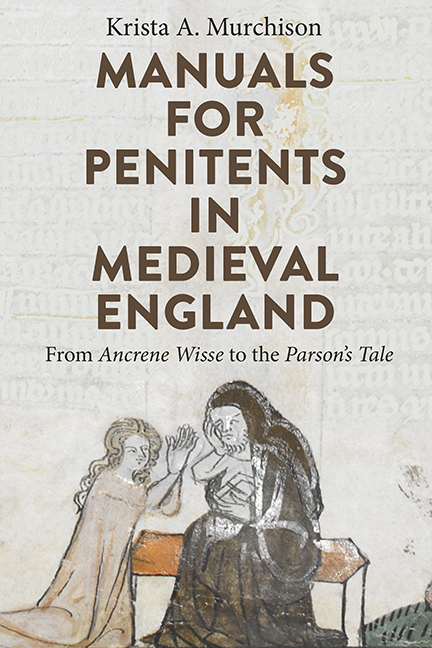Book contents
- Frontmatter
- Contents
- Acknowledgements
- Abbreviations
- Note on the Translation and Treatment of Texts
- A Chronological List of Key Manuals for Penitents and Associated Works
- Introduction: Teaching Sin
- Part I Self-Examination Writing before 1250
- Part II Manuals for Penitents, 1250–1300
- Part III Manuals for Penitents, 1300–1350
- ‘To enden in som vertuous sentence’: Concluding with Chaucer’s Parson
- Bibliography
- Index
Introduction: Teaching Sin
Published online by Cambridge University Press: 07 October 2022
- Frontmatter
- Contents
- Acknowledgements
- Abbreviations
- Note on the Translation and Treatment of Texts
- A Chronological List of Key Manuals for Penitents and Associated Works
- Introduction: Teaching Sin
- Part I Self-Examination Writing before 1250
- Part II Manuals for Penitents, 1250–1300
- Part III Manuals for Penitents, 1300–1350
- ‘To enden in som vertuous sentence’: Concluding with Chaucer’s Parson
- Bibliography
- Index
Summary
The author of the thirteenth-century religious guide Ancrene Wisse, echoing a sentiment shared among many of his contemporaries, insists that ‘Schrift ah to beon biþoht biuore longe’ (‘Confession ought to be thought out well beforehand’). Medieval penitents understood that before going to confess to a priest they had to prepare themselves through careful reflection on their sins. Doing so allowed them to make the kind of detailed, reflective, and personal confession that was considered essential for the salvation of the soul. Just as a single hole in a ship could drown a group of sailors, a single forgotten sin, according to the author of Ancrene Wisse, could sink a soul to the pits of hell.
The importance of penitential self-examination in the late medieval Church was the direct result of a decision that took place at the Fourth Lateran Council of 1215. Canon 21 of this council famously placed an unprecedented emphasis on confession by requiring those who had reached the age of majority to confess their sins to a priest at least once per year. This new Church-wide requirement created an urgent need for written works that could educate the public about the process of confession, and that could explain the abstract concept of sin through recognizable, real-world situations and desires. Among these works are some of the best-known literary creations from medieval England, including Robert Mannyng's Handlyng Synne (1303–1317) and Chaucer's Parson's Tale (c. 1400). Educational guides such as these traced the shape and topography of the human heart for medieval penitents by describing specific types of sins and how to recognize them; ‘Ȝyf þou yn yre a man hate’, one manual explains, ‘And þat wraþþe wylt nat late, / Greuusly þou art yn synne!’ (‘If you hate a man in a fit of anger, and refuse to let go of that wrath, you are sinning gravely!’).
These guidebooks, now known as ‘manuals for penitents’, make no attempt to hide their educational aims. One guide, written by the French King Philip III's confessor Friar Laurent, announces that anyone who uses it ‘i porroit mout profiter et aprendre, et counoistre toute maniere de pechié, et a soi bien confesser’ (‘could greatly profit and learn [from it], and identify all types of sin, and how to confess well’).
- Type
- Chapter
- Information
- Manuals for Penitents in Medieval EnglandFrom <i>Ancrene Wisse</i> to the <i>Parson’s Tale</i>, pp. 1 - 26Publisher: Boydell & BrewerPrint publication year: 2021



